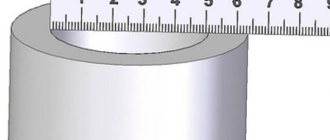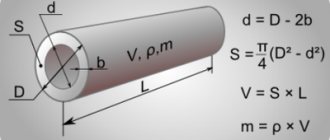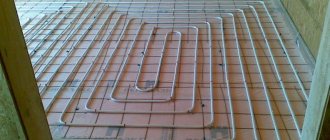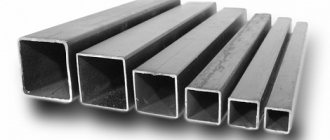Cylinder
A circular cylinder is a figure of rotation of a rectangle around any of its sides. The cylinder is characterized by two linear parameters: base radius r and height h. Below is a schematic diagram of what a circular straight cylinder looks like.
There are three important types of section for this figure:
- round;
- rectangular;
- elliptical.
An elliptical is formed as a result of a plane intersecting the side surface of a figure at a certain angle to its base. The circular is the result of the intersection of the cutting plane of the side surface parallel to the base of the cylinder. Finally, a rectangular one is obtained if the cutting plane is parallel to the axis of the cylinder.
The circular cross-sectional area is calculated by the formula:
S1 = pi*r2
The area of the axial section, that is, the rectangular section that passes through the axis of the cylinder, is determined as follows:
S2 = 2*r*h
What is the cross section measured in?
After determining the diameter using the indicated methods, the cross-sectional area can be determined using a formula or a special table. It is measured in square millimeters. This unit of measurement is derived according to the Unified International System of Measurements.
You may be interested in this The danger of step tension
Unit of measurement
At the same time, the cut of the vein was always round.
How can you do cross-section calculations?
Sometimes you have to measure the cross-section yourself because the wire is not marked. This is not a reason not to use it. First you need to find out what material the core was made of. There is white aluminum, red copper and yellow brass. After this, you need to calculate the area. To do this, you need to find out the conductor diameter by removing the insulation. The diameter can be measured using:
- caliper, micrometer;
- pencil and ruler.
Important! In the second case, the result will be approximate. It should be used in extreme cases. It is better to calculate the diameter using the formula and calipers.
Calipers
You can use a caliper to measure a wire of any size. To do this, you need to place it between calipers. Make sure that they are looking at the scale division. Then calculate the value.
Calipers
Whole numbers can be obtained on the upper scale, and decimals on the lower scale.
Pencil + ruler
If you don’t have a caliper, and the length of the exposed conductor allows you to wrap it around a pencil no less than 1 cm long, you can use this method. All you need is to count the turns that fit on a piece of length 1 cm. The diameter is obtained by dividing the length of the segment into turns.
Using a pencil and ruler, measurements will not be entirely accurate.
Note! The accuracy of the measurement will depend on how tightly the winding was made and how long it is.
Volumetric figures
It is known from stereometry that a three-dimensional figure of absolutely any type is limited by a number of surfaces. For example, for polyhedra such as a prism and a pyramid, these surfaces are polygonal sides. For a cylinder and a cone, we are talking about surfaces of rotation of cylindrical and conical figures.
You will be interested in: What does it mean to be reputed: interpretation, synonyms
If we take a plane and intersect the surface of a three-dimensional figure with it in an arbitrary manner, we will obtain a section. Its area is equal to the area of the part of the plane that will be located inside the volume of the figure. The minimum value of this area is zero, which is realized when the plane touches the figure. For example, a section that is formed by a single point is obtained if the plane passes through the top of a pyramid or cone. The maximum value of the cross-sectional area depends on the relative position of the figure and the plane, as well as on the shape and size of the figure.
Below we will consider how to calculate the areas of the formed sections for two figures of revolution (cylinder and cone) and two polyhedra (pyramid and prism).
Prism sections
A prism is a large class of figures that are characterized by the presence of two identical polygonal bases parallel to each other, connected by parallelograms. Any cross section of a prism is a polygon. Due to the variety of figures under consideration (oblique, straight, n-gonal, regular, concave prisms), the variety of their sections is also great. Below we will consider only some special cases.
If the cutting plane is parallel to the base, then the cross-sectional area of the prism will be equal to the area of this base.
If the plane passes through the geometric centers of the two bases, that is, it is parallel to the lateral edges of the figure, then a parallelogram is formed in the section. In the case of straight and regular prisms, the type of section under consideration will be a rectangle.
Scope of application
The cross section in the drawing is shown in the form of a figure, which is formed by dividing the part by a plane. Used in electrical engineering, electricity, when a conductor core is considered at right angles to its longitudinal half. Electrons pass through the divided core.
Note! The diameter of the core is not a cross-section. To determine the area of the core, you need to use a special formula for determining a circle.
Knowing the size of the wire cut, length and resistivity, you can find out what resistance the conductor has to the electric current passing through its structure. If you choose the wrong conductor cut, this can lead to a fire in the electrical wiring in the system as a result of its overheating and melting.
You may be interested in this: How to find out amperage
Construction is the main area of application for wires
The purpose of calculating the cross-sectional area may be to obtain the required amount of electricity for the normal operation of electrical appliances, to avoid overpayments with unused energy carriers, to connect powerful equipment to the mains voltage, to prevent a fire in the area, to avoid melting of the insulation layer, to prevent short circuits in household and industrial networks. It could also be getting the lighting system organized correctly.
For your information! The normal conductor cross-section for lighting is 1.5 mm² for the line and 4-6 mm² for the input.
Features of self-calculation
Independent calculation of the longitudinal section is performed on a core without an insulating coating. A piece of insulation can be moved or removed on a piece purchased specifically for testing. First you need to determine the diameter and find the cross section using it. Several methods are used for the work.
Using a caliper
The method is justified if the parameters of a truncated or defective cable are measured. For example, VVG may be designated as 3x2.5, but in fact be 3x21. Calculations are made as follows:
- The insulating coating is removed from the conductor.
- The diameter is measured with a caliper. You will need to place the wire between the legs of the instrument and look at the scale markings. The integer value is on top, the decimal value is on the bottom.
- Based on the formula for finding the area of a circle S = π (D/2)2 or its simplified version S = 0.8 D², the cross section is determined.
- The diameter is 1.78 mm. Substituting the value into the expression and rounding the result to hundredths, we get 2.79 mm2.
For domestic purposes, you will need conductors with a cross section of 0.75; 1.5; 2.5 and 4 mm2.
Using a ruler and pencil
Calculating PS using a ruler and pencil
If you don't have a special meter, you can use a pencil and ruler. Operations are performed with the test image:
- An area of 5-10 cm is cleared of the insulating layer.
- The resulting wire is wound around a pencil. Full turns are laid tightly, there should be no space between them, the “tails” are directed up or down.
- Ultimately, a certain number of turns should be obtained; they need to be counted.
- The winding is applied to the ruler so that the zero division coincides with the first winding.
- The length of the segment is measured and divided by the number of turns. The resulting value is the diameter.
- For example, it turned out 11 turns, which occupy 7.5 mm. When dividing 7.5 by 11, 0.68 mm is the cable diameter. The cross section can be found using the formula.
The accuracy of the calculations is determined by the density and length of the winding.
Table of correspondence between wire diameter and cross-sectional area
If it is not possible to test the diameter or make a calculation when purchasing, you can use a table. The data can be photographed, printed or transcribed, and then used to find the standard or popular core size.
| Cable diameter, mm | Conductor cross-section, mm2 |
| 0,8 | 0,5 |
| 0,98 | 0,75 |
| 1,13 | 1 |
| 1,38 | 1,5 |
| 1,6 | 2 |
| 1,78 | 2,5 |
| 2,26 | 4 |
| 2,76 | 6 |
| 3,57 | 10 |
When purchasing an electrical cable, you will need to look at the parameters on the label. For example, VVNG 2x4 is used. The number of cores is the value after “x”. That is, the product consists of two elements with a cross section of 4 mm2. Based on the table, you can check the accuracy of the information.
Most often, the cable diameter is smaller than stated on the package. The user has two options - use a different one or choose a cable with a larger cross-sectional area in diameter. Having chosen the second one, you will need to check the insulation. If it is not solid, thin, or varies in thickness, choose products from another manufacturer.










